Gregory A. Fournier's Blog, page 45
May 28, 2013
John Norman Collins - Verdict and Sentence
 On Friday, January 16, 1970, the people's case against John Norman Collins finally went to the jury.
On Friday, January 16, 1970, the people's case against John Norman Collins finally went to the jury. They had been sequestered in a hotel for a full month during the trial proceedings. Now, after lunch at an undisclosed Ann Arbor restaurant, they returned to the jury room to begin deliberations at 1:10 PM. They retired for the evening at 9:30 PM.
On January 20, 1970, after four stressful days, one-hundred and one hours and thirty minutes since the jury began deliberations, the jury foreman informed the bailiff that they had arrived at a verdict.
The jury had weighed the evidence for a total of twenty-seven hours, heard five and a half hours of trial testimony read back to them, and listened to the judge's instructions for a second time. The jury brought a murder in the first degree verdict against John Norman Collins for the wrongful death of Karen Sue Beineman.
Collins' mother Loretta audibly gasped when she heard the words no mother should hear, but many other Michigan mothers felt some level of relief at the headlines screaming out from the newspapers: Collins Found Guilty.
Washtenaw County District Court Judge John W. Conlin set the date for sentencing as Wednesday, August 28th, 1970.
 On the appointed day with a courtroom packed mostly with press, the defendant and his family heard Judge Conlin pass the mandatory sentence: "Life in prison without possibility of parole at hard labor in solitary confinement."
On the appointed day with a courtroom packed mostly with press, the defendant and his family heard Judge Conlin pass the mandatory sentence: "Life in prison without possibility of parole at hard labor in solitary confinement." One hour after the court proceedings, Collins was in a prison van headed for Jackson State Prison.
As imposing as that may sound, Michigan Department of Corrections spokesperson told the press that the hard labor and solitary provision had not been enforced in Jackson State Prison for "the past fifteen years or so." It is impossible to do both at the same time, he said, so other inmate management plans were in place.
The press also learned that new prisoners are eased into the prison population for the first thirty days. Collins would be quarantined for testing and an adjustment period.
Physicals, aptitude, intelligence, and psychological tests (which Collins has tacitly refused to take) are given to new arrivals. This helps prison committees determine the best placement for offenders and eligibility for parole.
Collins managed to work a number of menial jobs until he secured a job tutoring other inmates, which his supervisors thought he was good at, particularly with difficult inmates. In that job, he was able to meet people from many different areas of the prison.
While working at a food service job, a large amount of sugar was found missing from the kitchen pantry. When some inmates were caught with "spud juice" one evening. Collins was implicated in the sugar theft and the making of potato vodka. He soon lost all of his job privileges.
***
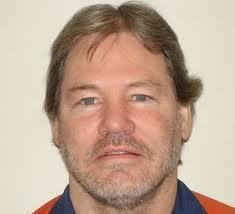
Today, John Norman Collins is on Administrative Segregation at Marquette Prison and spends most of the day in his cell with the exception of a one hour exercise period. Weightlifting, a life long interest, is difficult these days because of knee and back injuries. To complicate matters, rumor has it that Collins had a mild stroke in the early spring of 2012.
Prison reports have it that Collins has taken to feeding birds during his exercise breaks, and he has in fact been reprimanded by prison officials for that. The birds recognize him when he is in the yard earning him the sobriquet, "the bird man."
Because of several attempts over the years to escape from prison, Collins has earned a Level Five security classification. He can not be trusted to work any prison job, but he has his own cell with a television, a prison bed, a small writing area, a bookshelf, and a toilet. So at least the solitary confinement part of his original sentence is being served - sort of.
In the early 1980's, John Norman Collins quietly changed his name to John Norman Chapman and started to engineer another way out of serving his full prison sentence. He hearkened to his Canadian roots.
Published on May 28, 2013 21:12
May 25, 2013
Zug Island - Focal Point of Windsor Hum?
 Zug Island from Windsor, Ontario
Zug Island from Windsor, OntarioFor the last several years, residents of Windsor, Ontario, have complained of a low frequency hum which rattles their windows and keeps them awake at night. Canadian scientists have pinpointed the source as Zug Island, an industrial complex on the United States side of the Detroit River.
 Because the blast furnace and coke oven industrial complex is an international border installation, it has come under the aegis of Homeland Security. Surveillance has been beefed up and one of two entrances to the island has been blockaded and fenced off. The exaggerated security of Zug Island combined with the mysterious hum has led to a number of conspiracy theories.
Because the blast furnace and coke oven industrial complex is an international border installation, it has come under the aegis of Homeland Security. Surveillance has been beefed up and one of two entrances to the island has been blockaded and fenced off. The exaggerated security of Zug Island combined with the mysterious hum has led to a number of conspiracy theories. The SyFy Network is sending Joe Rogan to Detroit to look into this matter, and I've been asked to participate because of my previous on-the-job experience working there and my knowledge of the plant. The producers saw my book, Zug Island: A Detroit Riot Novel, and thought I could add something to their documentary. I'm not a conspiracy theorist, but this project is kookie enough to interest me.
To learn more about the the Windsor Hum, view the link below:
http://www.indiegogo.com/projects/zug-island-the-story-of-the-windsor-hum
Published on May 25, 2013 10:15
May 21, 2013
Gregory A. Fournier on Blogging and Branding
 After a lifetime of teaching English Language Arts, I was ready to try my hand at something else in retirement.
After a lifetime of teaching English Language Arts, I was ready to try my hand at something else in retirement.Rather than read and/or teach fiction, I wanted to see if I could write a full length novel, so I began writing Zug Island: A Detroit Riot Novel. (See link.)
The transition from being a writing instructor to becoming an author was not a huge leap for me. Learning how to present and market my work has been the persistent challenge.
In addition to traditional publishing which has long dominated the writing market, the explosion of self-published Printing on Demand (POD) books has glutted the marketplace making the field even more crowded.

I've found that speaking at libraries, bookstores, and book clubs is not the best way to attract readers and sell books. Those venues place the author in direct contact with some readers, but the reach of such events is limited.
Reluctantly at first, I decided to blog at the insistence of my publicist, Paula Margulies. "You need to establish yourself and your blog as a brand," she said. "That's how you build an audience from the ground up."
I soon discovered that the care and feeding of a blog required a minimum of one post a week. Anything less than that and readers sense a lack of commitment and lose interest.
I feared that I would be spending more time writing blog posts than on my current project, The Rainy Day Murders, about the John Norman Collins coed killings in Ann Arbor and Ypsilanti, Michigan.
Coming up with new material and keeping readers interested in my writing is work, no doubt about it. But what I originally thought I would dread has become an interesting exercise in honing my style and establishing my author's voice.

My blog has grown steadily over the last two years helping me to interact and create a fan base which is opening some doors for me in the media and publishing business.
What I once dreaded is now something I look forward to doing. Publishing a blog not only reaches out to potential readers, it also helps me work out my ideas for the book I'm writing. It allows readers to feel a sense of "behind the scenes" which helps me build and maintain an audience.
Effective blogging creates a sense of immediacy for the reader and a sense of instant gratification for the writer who can now publish with a simple stroke on the keyboard. My blog is a virtual electronic business card open twenty-four hours a day, everyday, and it's reach is global.
***
In April of this year, I was interviewed by a reporter from Eastern Michigan University for their alumni website and monthly print publication. Here is the link to that article.
http://emuyoungalumni.wordpress.com/2013/04/29/gregory-fournier-a-story-worth-telling/
Published on May 21, 2013 11:07
May 14, 2013
The Medieval Clink Prison (1144-1780)

Established in 1144 AD, "The Clink" was the prison that gave its name to all others. The name derived from the clinking sound made by the blacksmith when closing the irons around the wrists and ankles of prisoners. The prison was located on the south side of the Thames River just west of the London Bridge in an area named Southwark.
Originally, the prison was built within palace walls owned and operated by the Bishop of Winchester. It served as the bishop's private goal (jail).
Southwark became the place where the people of London went for their adult entertainment, much like Las Vegas is today for many Americans. It was louder, cruder, and more notorious than staid London across the river.
Activities which were illegal north of the Thames were given free rein on the south side of the river. Drinking and carousing were popular past times. Bull and bear baiting attracted gamblers, as did dog fighting and cock fights. There were twenty-two bath houses (brothels) along Bankside, and in 1587 AD, the new playhouses added to the general lawlessness as petty crimes were rampant and cut purses (pick pockets) worked the area.
Over its six-hundred year history, the Clink has held debtors, heretics, drunkards, prostitutes, thieves, political prisoners, Protestants, Catholics, and the pilgrim fathers before they shipped out to America.
Despite barbaric prison conditions, punishment was not the purpose of Medieval prisons. Prisons were used to confine the accused before his or her trial. The punishment came after the trial.
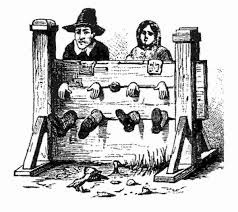 For minor offenses, a prisoner could be locked in the stocks for a public show of humiliation or taken to a pillory where the guilty party would be tied to the whipping post for a public scourging.
For minor offenses, a prisoner could be locked in the stocks for a public show of humiliation or taken to a pillory where the guilty party would be tied to the whipping post for a public scourging. For capital crimes, a person could have his head chopped off, get his neck stretched by the business end of a rope, or be burned at the stake if you were a religious heretic. Executions were popular forms of entertainment in those times and drew huge crowds.
The lower cellars of the prison would regularly flood during high tides and prisoners would have to stand waist high in sewage and human waste. Waterborne infections killed countless people with diseases like Camp Fever (typhoid), The Ague (malaria), and The Flux (dysentery). During the plague years, the Clink must have resembled Hell itself as bodies were piled up outside the prison waiting to be hauled away for hasty burial.
Because of the accumulated filth, William de Rakyer was hired in 1375 to rake up the muck. This is believed to be the origin of the term "muckraker" used in politics.
In a footnote to history, King Henry II in 1161 issued fifty-two regulations for the Bankside "stews" in an effort to regulate prostitution. The working girls were not allowed to cheat their patrons, nor could they be forced into that line of work. Women for the first time were allowed to earn an income and achieve a level of independence from men hitherto unknown.
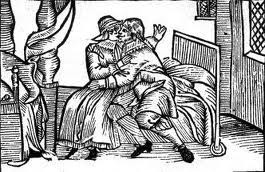
Ironically, the Bishop of Winchester owned several of these "rented" houses and made a sizable income from the wages of sin. The girls were nicknamed "Winchester Geese" partially because of the white aprons and yellow hoods they were required to wear by law.
The brothels were called stews, which is believed to be a corruption of the Old French word for stove - estuve - for the "hot work done in them."
For the first time, these women had some immunity from prosecution and could ply their trade without constant fear of arrest and incarceration in the Clink.
http://www.clink.co.uk/
Published on May 14, 2013 09:13
May 7, 2013
More Theater Lore
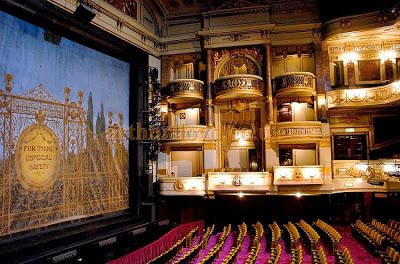 London's oldest theater site, Theater Royal Drury Lane, opened in 1663 in the early years of the English Reformation. Four theaters have occupied this site over the years.
London's oldest theater site, Theater Royal Drury Lane, opened in 1663 in the early years of the English Reformation. Four theaters have occupied this site over the years. The first theater burned down in 1672. It was rebuilt by Christopher Wren and reopened on March 26, 1674. One-hundred and seventeen years later, Irish playwright, Richard Brinsley Sheridan had the building demolished and opened a larger theater in 1794. That building burned down only fifteen years later in 1809. The current building was rebuilt and reopened in 1812. Presently, it is owned by Andrew Lloyd Webber.
Learning about theater lore from a backstage tour is a fascinating excursion into the past. On the Royal Drury Lane Theatre tour at Covent Garden in London, the tour includes guides who dress in period costumes as they trade off their docent duties for quick costume changes.
At one moment, a Victorian cleaning woman comes singing "I could have danced all night" down a staircase with a feather duster, then an eighteenth-century, English nobleman in costume suddenly appears and continues the tour. Next, a woman from the gaslight period comes out in a red dress and tells about how the theater was in her day. The tour is quite entertaining.
***
Learning the origins of words from these tours is an article of faith, but because it is lore, I have a willing suspension of disbelief. For instance, I learned that the term "crew" as applied to the backstage crew derives from a little known fact.
Theater Royal Drury Lane was really the first modern proscenium arch theater which provided a visual frame for the audience with permanent wings to the left and right of the stage to hide and shift scenery on and off the stage. This reincarnation of the Royal Drury Lane burned down in 1809.
In the early nineteenth-century, the new theater owners rebuilt and redesigned the theater once again. They hired out of work sailors who were between sea tours to work backstage; they became known as "the crew." These sailors devised the system of pulleys and battens which raise and lower scenery from the loft above. This innovation created new staging opportunities for playwrights and directors.
***
 On the Shakespeare's Globe Theater tour, I learned the origin of the term "box office."
On the Shakespeare's Globe Theater tour, I learned the origin of the term "box office." At the various entrances to the original Medieval theaters in the sixteenth-century, patrons would place their pennies in a ceramic box as they entered the theater. These boxes were collected at the box office and broken open there for security reasons.
Today, box offices are where patrons purchase tickets for events, but the term has an additional context also. It has come to be associated with the amount of money a movie or play takes in.
"Good box office" means the production is making money; "Box office poison" means the producers are losing money. Weekly and yearly figures are important to the entertainment industry and are reported widely around the world.
Published on May 07, 2013 11:18
May 2, 2013
Victorian Theater and The Limelight
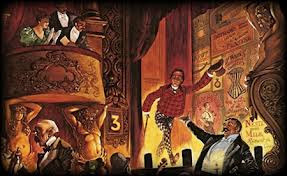
In the Victorian period, the expression "in the limelight" meant the most desirable acting area on the stage, front and center. Today, the expression simply means that someone is getting public recognition and acclaim.
The limelight effect was discovered by Goldsmith Gurney in the 1820s based on his work with an oxy-hydrogen blowpipe. Scottish inventor, Thomas Drummond (1797-1840), built a working model of the calcium light in 1826 for use in the surveying profession.
The calcium light was created by super heating a cylinder of quicklime (calcium oxide) with an oxy-hydrogen flame that gives off a bright light with a greenish tint.

Eleven years later, the term "limelight" was coined to describe a form of stage illumination first used in 1837 for a public performance at the Covent Garden Theatre in London.
By the 1860s, this form of stage lighting was in wide use in theaters and dance halls around the world. This new technology was a great improvement over the previous method of stage lighting, candle powered footlights placed along the stage apron.
Limelight lanterns could also be placed along the front of the lower balcony for general stage illumination providing more "natural" light than footlights alone could.
A lighthouse-like lens was developed that could direct and focus concentrated light on the stage to spotlight a solo performance. Actors and performers must have felt like they were living in the heyday of the theater.
The term "green room" has also been in use since the Victoria period to describe the waiting area performers used before they went on stage. Theater lore has it that actors would sit in a green room lit by limelight to allow their eyes to adjust to the harsh stage lighting, thereby preventing squinting during their stage entrances.
Although the electric light replaced limelight in theaters by the end of the nineteenth century, the term "limelight" still exists in show business, as does the term "green room."
Today, the "green rooms" that celebrities use before they appear on talk shows are not usually painted green. The rooms still perform a similar function as they did in the Victoria age though, to prepare a performer to go on stage.
Published on May 02, 2013 02:00
April 26, 2013
Gregory A. Fournier Speaks about Zug Island on the Michael Dresser Show
 On Friday, April 19, 2013, I did a web radio interview for the Michael Dresser Show. It has been a while since I had done any live Zug Island promotion, but with summer coming, I thought it might be a good time to let readers know that Zug Island makes a great vacation read.
On Friday, April 19, 2013, I did a web radio interview for the Michael Dresser Show. It has been a while since I had done any live Zug Island promotion, but with summer coming, I thought it might be a good time to let readers know that Zug Island makes a great vacation read.Despite its serious subject matter, race relations during the summer of the Detroit Riots, Zug Island is an often humorous account of a college dropout and an intercity young man who fall in and out of rhythm on Detroit's mean streets to discover that the face of racism comes in every shade of color.
 Zug Island is a blue collar, coming of age, buddy novel which tells a slice of history much neglected in the telling of this horrible period of Detroit's history. It's been almost fifty years since July 23, 1967, and the city has yet to recover from its conflagration.
Zug Island is a blue collar, coming of age, buddy novel which tells a slice of history much neglected in the telling of this horrible period of Detroit's history. It's been almost fifty years since July 23, 1967, and the city has yet to recover from its conflagration.Amidst all the devastation, an unlikely friendship endures which suggests that hope for the city's recovery lies with its people and not its politicians.
Listen to my latest Zug Island web radio interview (15 minutes):
http://michaeldressershow.com/wp-content/uploads/2013/04/Greg-Fournier-4-19-2013.mp3
Published on April 26, 2013 20:21
April 20, 2013
Willie O'Ree - First Black Player in the National Hockey League - Meets Jackie Robinson - First Black Player in Major League Baseball
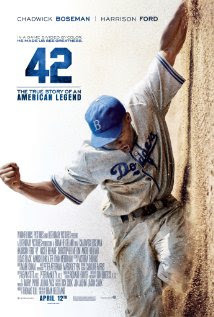 Now that the new Jackie Robinson movie, 42, is out and in theaters, I am reminded of a story my friend, Willie O'Ree, told me about having the honor of meeting Mr. Robinson twice in his life. What makes this story interesting is that Willie is best known as the first black player in the National Hockey League.
Now that the new Jackie Robinson movie, 42, is out and in theaters, I am reminded of a story my friend, Willie O'Ree, told me about having the honor of meeting Mr. Robinson twice in his life. What makes this story interesting is that Willie is best known as the first black player in the National Hockey League.When Willie was fourteen years old in Fredericton, New Brunswick, Canada, his baseball team won the league championship. The team's reward was to go down to New York City to watch the Brooklyn Dodgers play at Ebbets Field.
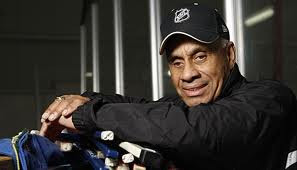
Before the game, Jackie Robinson had a meet and greet session with the Fredericton champs. When it was Willie's turn to meet Mr. Robinson, he told the sports hero that he played hockey as well. Mr. Robinson said he didn't know that black kids played hockey. "They do in Canada," Willie said.
Many years later in 1962, the National Association for the Advancement of Colored People gave a luncheon to honor the baseball legend and to commemorate the breaking of Major League Baseball's color line.
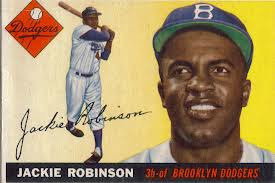
Willie O'Ree was invited to attend the luncheon and Mr. Robinson remembered him from their earlier meeting thirteen years before. I wish I had a photo of that meeting of the sports icons to show you.
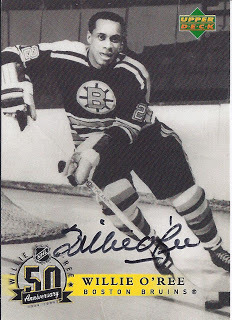 These two sports figures, confident in their places in history as integration pioneers, are what this country is sorely in need of today - worthy heroes who can bring us together as a nation.
These two sports figures, confident in their places in history as integration pioneers, are what this country is sorely in need of today - worthy heroes who can bring us together as a nation.Willie O'Ree - Canadian Interview Link: http://www.youtube.com/watch?v=g5Wm-TvmC4Q
Published on April 20, 2013 16:26
April 17, 2013
John Norman Collins, aka Bill Kenyon - The 8mm Muscleman
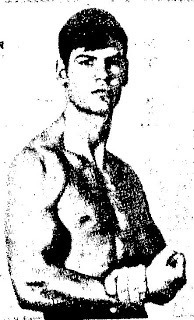 My search for reliable information to restore the facts of the Rainy Day Murders has been a Sisyphean task.
My search for reliable information to restore the facts of the Rainy Day Murders has been a Sisyphean task. Drawing together what is known about John Norman Collins and the "coed killings" in one place is a huge undertaking but long overdue.
My researcher, Ryan M. Place, and I have invoked the Freedom of Information Act (FOIA) to obtain documents from the Michigan Department of Corrections, the Michigan State Police, and the Washtenaw County Coroner's Office, with several more government agencies pending.
Despite major gaps in the public records, we have discovered some interesting information by scouring through these boxes of government documents. Among the more surprising finds are some items on an evidence log in the Karen Sue Beineman case folder.
Somewhere in the Michigan State Police vault in East Lansing, Michigan, there are weightlifting photos of John Norman Collins posing for Tomorrow's Man magazine as Bill Kenyon. He appeared in the September, 1969, issue which came out on newsstands at roughly the same time he was arrested for the first-degree murder of Karen Sue Beineman.
***
Tomorrow's Man was a pulp magazine popular in some male circles in the 1950s and 1960s. Under the guise of male physical fitness and weightlifting, the magazine was available on newsstands across the country and was often a young man's first exposure to alternative male lifestyles. Their magazine's motto was "Hunks in Trunks."
This was before gay rights and the lessening of the social stigma against male homosexuality. By the end of the 1960s, American culture underwent a fundamental shift in cultural mores. Tomorrow's Man became obsolete and went out of business. The magazine's back issues are collector's items and very hard to obtain. (See the link below for some of their iconic cover art.)
***
My researcher and I have made an additional FOIA request for the photos of JNC posing for Tomorrow's Man magazine. These items were not used as evidence in the case, and the Michigan State Police has determined that they have no monetary value.two 8x10 black and white stills of Collins posingone 8x10 contact proof sheet with twelve posesone copy of Tomorrow's Man magazine showing Collins posing as Bill Kenyonfourteen color pictures of Collins posingand a must see to believe - twenty-five foot long reel of 8mm film of John Norman Collins striking poses. Last week, I wrote a Michigan State Police detective who has worked on these cases recently. I asked him to suggest to his commander that the state police consider digitizing the 8mm film stock before it fades to nothing and turns brittle in the can. If Ryan and I are successful in obtaining this film, we will post it on YouTube.
At the very least, we hope to secure some decent scans of photographs to include in a photo bank in the true crime book I'm writing, The Rainy Day Murders. The photograph of Collins above is a photocopy taken from a vintage Detroit Free Press article dated August 30, 1970.
http://www.pulpinternational.com/pulp/entry/Assorted-covers-of-Tomorrows-Man-bodybuilding-magazine.html
Published on April 17, 2013 17:39
April 16, 2013
John Norman Collins Composite Drawings
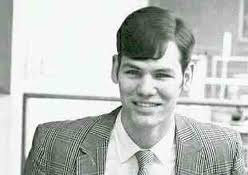 John Norman Collins
John Norman CollinsA week after she had turned up missing, Joan Schell's body was found murdered on the northern outskirts of Ann Arbor. She was seen hitchhiking in front of McKinney Student Union on the campus of Eastern Michigan University on June 30th, 1968. She had accepted a ride from three young men in a red car with a black vinyl top.
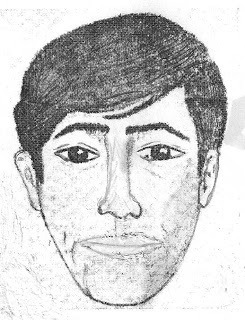 Ann Arbor Police Composite Drawing 1968
Ann Arbor Police Composite Drawing 1968An Ann Arbor police artist made a composite drawing of one of the young men from an eyewitness account of Joan's roommate who was waiting with her at the bus stop.
She got a good look at one of the guys when he got out of the car and opened the rear door for Joan to get into the backseat.
Joan was desperate to get to Ann Arbor to see her boyfriend; she had missed the last bus of the evening and started hitchhiking which placed herself at an elevated risk.
The next eyewitness sighting of the person thought to be the coed killer was made a year later by a wig shop owner and her wig stylist employee. Both women took a hard look at the person mounted on a motorcycle waiting for their customer, Karen Sue Beineman, to return.
She confided in the two women that she had done two things she had never done before, bought a wig and taken a ride from a stranger on a motorcycle. The hair stood up on the back of both women's necks. Six young women had turned up murdered in the Ypsilanti area in the last two years.
They tried to talk Miss Beineman out of getting back on the motorcycle for the ride back to her dormitory, Downing Hall. Joan Goshe, the shop owner, even offered to drive Karen back in her own car. Ironically, Karen didn't want to trouble her. Several days later, the young coed's body was found and became the seventh victim of what the public believed to be a psychopathic, multiple murderer.
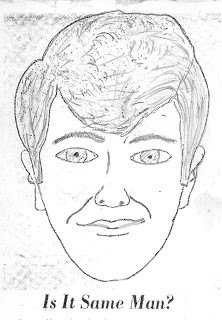 Ypsilanti Police Composite Drawing 1969
Ypsilanti Police Composite Drawing 1969The wig shop ladies, Diane Joan Goshe and Patricia Spaulding, gave an Ypsilanti police artist a description of the young man they saw riding off with Karen Sue Beineman that day outside the wig shop.
If anything, this drawing was sketchier that the former composite drawing done in Ann Arbor, but still, there was a passing similarity between the two.
The driver of the motorcycle was described as a white male about twenty years old, maybe six feet tall, and with short brown hair curled down over the forehead with short sideburns. Women at the University of Michigan and Eastern Michigan University were frightened out of their wits.
One EMU art student was appalled at the poor quality of the composite drawings and offered her services to the police. Twenty-one year old Barbara Martin drew a pastel colored, composite drawing in much greater detail than the previous attempts.
Her drawing showed the suspect with curly hair as described by the wig shop ladies. The motorcycle driver was driving without a helmet which may have accounted for the curly hair detail.
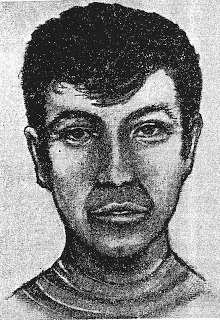 Barbara Martin Composite DrawingHundreds of copies were made of her drawing and distributed throughout the area. This experience led Ms. Martin into a long career of forensic art, producing composite drawings generated from the description of victims or witnesses.
Barbara Martin Composite DrawingHundreds of copies were made of her drawing and distributed throughout the area. This experience led Ms. Martin into a long career of forensic art, producing composite drawings generated from the description of victims or witnesses.Barbara Martin also specialized in rebuilding faces on skulls with clay to produce three dimensional images of unidentified crime victims.
She studied in two areas of facial reconstruction, the European and the American method. The American method relies more on sculpture than anatomy.
Today, Barbara Martin Bailey is retired and volunteers for Project Everyone Deserves a Name, an organization that puts faces on unrecognizable victims. She is considered a world-class forensic artist.
More on forensic art: "The Art of Science"
http://news.medill.northwestern.edu/chicago/news.aspx?id=88093&print=1
Published on April 16, 2013 15:13



